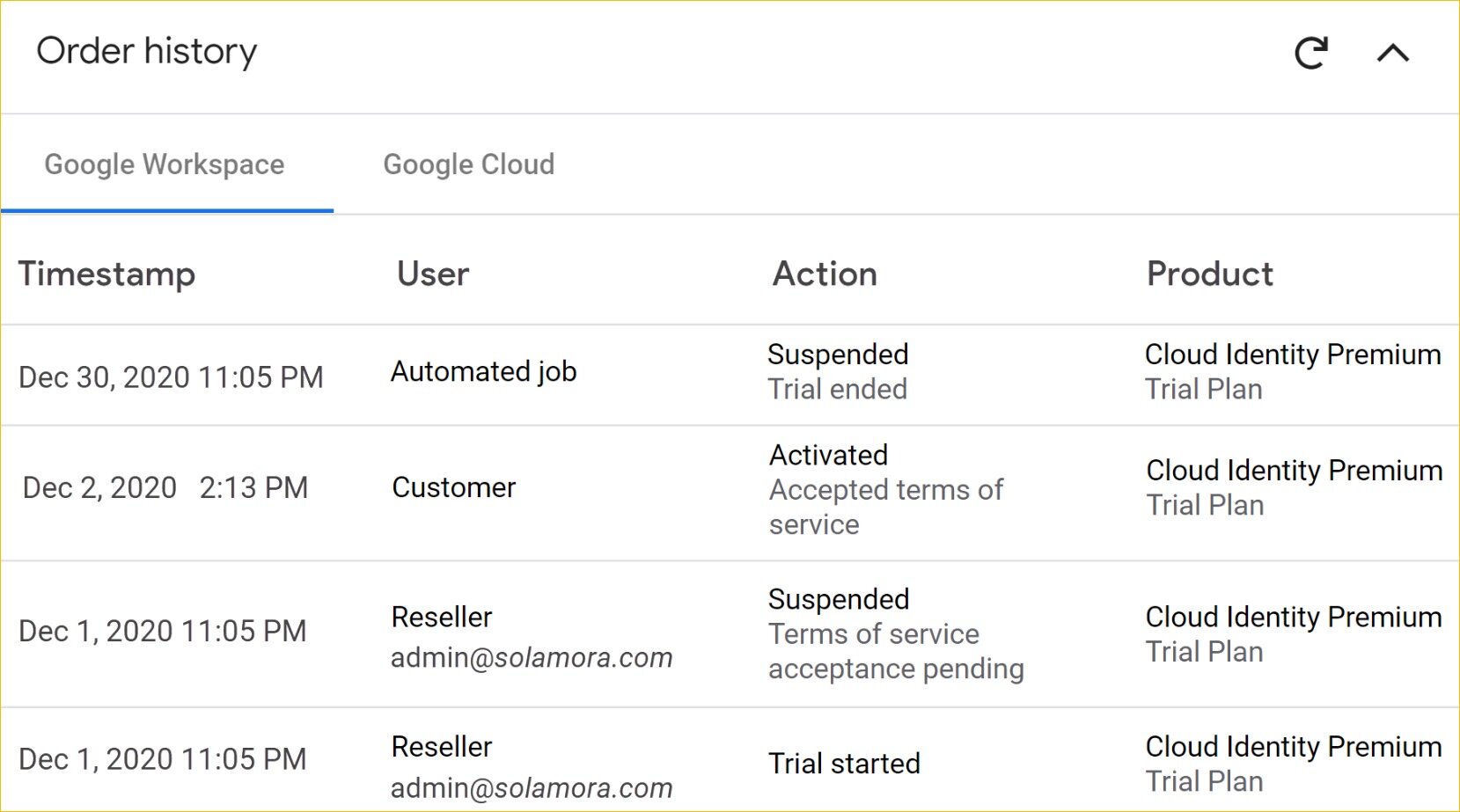Introduction
Welcome to the world of Google Workspace reselling! If you are a tech enthusiast looking for a rewarding career opportunity, becoming a Google Workspace reseller could be the right path for you. In today’s digital era, businesses of all sizes are turning to cloud-based productivity tools to streamline operations and improve collaboration. Google Workspace, formerly known as G Suite, offers a comprehensive suite of applications such as Gmail, Google Docs, Google Sheets, and Google Drive, which are widely used by individuals and organizations around the world.
As a Google Workspace reseller, you have the chance to not only leverage these powerful tools for your own business but also to provide them to others, earning a profit in the process. By partnering with Google, you gain access to their established reputation, extensive customer base, and ongoing support, making it easier for you to market and sell these tools to potential customers. Plus, with Google constantly innovating and adding new features to their suite of applications, you can offer clients the latest advancements in productivity technology.
But how can you become a Google Workspace reseller? In this article, we will guide you through the process step-by-step, outlining the prerequisites, application process, training and certification, account setup, sales and marketing strategies, customer management, and billing and support. By the end, you will have a clear understanding of what it takes to become a successful Google Workspace reseller and how to navigate this exciting venture.
So, if you’re ready to embark on a new career path that combines your passion for technology with the potential for financial success, let’s dive into the world of Google Workspace reselling and discover how you can become a part of this thriving ecosystem.
What is Google Workspace?
Google Workspace, formerly known as G Suite, is a cloud-based productivity suite developed by Google. It offers a range of applications and tools designed to enhance collaboration, communication, and productivity for businesses of all sizes. With Google Workspace, users can access their files, emails, and documents from anywhere, at any time, using any device with an internet connection.
The core applications of Google Workspace include Gmail, Google Docs, Google Sheets, Google Slides, and Google Drive. Gmail is a popular email service that provides a professional email address, powerful spam filtering, and ample storage space. Google Docs, Google Sheets, and Google Slides are online document, spreadsheet, and presentation editors, respectively. These applications allow multiple users to collaborate in real-time, making it easy to work on projects together, whether they are in the same office or located across the globe. Google Drive is a cloud storage solution that integrates seamlessly with other Google Workspace applications, allowing users to store and share files securely.
In addition to these core applications, Google Workspace offers several other tools that help businesses streamline their operations. Google Calendar enables users to manage their schedules and appointments, while Google Meet provides video conferencing capabilities for remote meetings. Google Forms allows for easy creation of online surveys and polls, and Google Sites offers the ability to build simple websites without any coding knowledge.
What sets Google Workspace apart from other productivity suites is its ability to integrate with other Google services. Users can leverage the power of Google’s search engine, artificial intelligence, and machine learning technologies to enhance their productivity. Additionally, Google Workspace provides robust security features, such as two-factor authentication and advanced data encryption, ensuring the confidentiality and integrity of users’ information.
Overall, Google Workspace offers a comprehensive and user-friendly suite of productivity tools that empower businesses to work efficiently and collaboratively. By becoming a Google Workspace reseller, you have the opportunity to introduce these powerful tools to businesses, helping them transform the way they work and increasing their productivity.
Why become a Google Workspace reseller?
Becoming a Google Workspace reseller presents a multitude of benefits and opportunities for individuals and businesses. Whether you are an entrepreneur looking to start a new venture or an existing technology company seeking to expand your product offerings, here are some compelling reasons why you should consider becoming a Google Workspace reseller:
1. Lucrative Revenue Stream: As a Google Workspace reseller, you have the potential to generate significant revenue. With a growing demand for cloud-based productivity tools, businesses are actively seeking reliable providers. By offering Google Workspace, you can tap into this market and earn a profit through sales and recurring subscription fees.
2. Established Brand Reputation: Partnering with Google lends credibility and trust to your business. Google is a globally recognized technology leader with a strong brand reputation. By aligning yourself with Google Workspace, you gain instant recognition and the assurance of delivering a high-quality product to your customers.
3. Extensive Customer Base: Google Workspace has a vast and diverse customer base, ranging from small startups to large enterprises. By becoming a reseller, you gain access to Google’s existing customer network, saving you the time and effort of building a customer base from scratch.
4. Ongoing Support and Updates: Google is committed to continuous improvement and regularly releases updates and new features for Google Workspace. As a reseller, you can offer your customers the latest advancements in productivity technology, ensuring they have access to the most up-to-date tools for their business needs.
5. Flexibility and Scalability: As a Google Workspace reseller, you have the flexibility to tailor your offerings to meet the unique needs of your customers. You can provide personalized solutions, integrate additional services, and scale your business as your customer base grows.
6. Marketing Tools and Resources: Google provides resellers with a range of marketing materials and resources to help promote and sell Google Workspace. From co-branded collateral to marketing campaigns, these tools can assist you in effectively reaching your target audience and driving sales.
7. Business Growth Opportunities: Offering Google Workspace opens doors to other business opportunities. As customers rely on you for their productivity needs, you can expand your services to include consulting, training, and support, further diversifying your revenue streams.
By becoming a Google Workspace reseller, you align yourself with a leading cloud-based productivity suite, gain access to a vast customer base, and position your business for long-term success in the ever-evolving digital landscape.
Prerequisites for becoming a reseller
Before you embark on your journey to become a Google Workspace reseller, there are some prerequisites you should be aware of. While these may vary depending on your location and specific circumstances, here are some common requirements:
1. Business Entity: To become a Google Workspace reseller, you typically need to operate as a legal business entity. This can be a sole proprietorship, partnership, LLC, or corporation, depending on your country’s regulations. It’s important to ensure that you have the necessary legal structure in place before proceeding.
2. Business Experience: While not mandatory, having prior experience in the technology industry or related fields can be advantageous. Familiarity with cloud computing, productivity tools, and IT services can help you better understand and address the needs of potential customers. However, with the right training and resources, anyone with a passion for technology can become a successful reseller.
3. Sales and Marketing Skills: As a reseller, your success will depend on your ability to market and sell Google Workspace effectively. Having strong sales and marketing skills, including lead generation, customer acquisition, and relationship management, can give you a competitive edge. You should be capable of articulating the value proposition of Google Workspace and demonstrating how it can benefit businesses.
4. Financial Stability: Start-up costs and ongoing expenses are involved in setting up and running a reseller business. You will need to have adequate financial resources to cover these costs, including marketing activities, training, infrastructure, and staff. A solid financial plan will help ensure that your reseller venture is sustainable in the long term.
5. Technical Expertise: While not mandatory, having a strong foundation in technology, particularly with regards to cloud computing and software applications, is advantageous. This will allow you to provide technical support, troubleshoot issues, and offer guidance to your customers. Additionally, having a basic understanding of HTML, CSS, and website design can be helpful when customizing and branding the Google Workspace experience for your clients.
6. Partner Program Requirements: Google may have specific partner program requirements that you need to fulfill. These can include minimum sales targets, customer retention goals, or training and certification prerequisites. It’s important to review and understand the criteria set by Google for resellers to ensure you meet the necessary qualifications.
7. Commitment and Dedication: Building a successful reseller business takes time, effort, and dedication. You need to be committed to learning about Google Workspace, staying up-to-date with product updates, and continuously improving your sales and marketing strategies. Having a strong work ethic and a passion for helping businesses succeed will drive your success as a reseller.
By ensuring you meet these prerequisites, you will be well-positioned to embark on your journey as a Google Workspace reseller and maximize your chances of success in this dynamic and ever-growing market.
Step 1: Apply to become a Google Workspace reseller
The first step in becoming a Google Workspace reseller is to apply for the reseller program. This application process allows Google to evaluate your business and ensure that you meet the necessary criteria to become a reseller. Follow these steps to apply:
1. Visit the Google Workspace Reseller Program Website: Start by visiting the official Google Workspace Reseller Program website. Here, you will find detailed information about the program and access to the application form.
2. Review the Program Requirements: Before applying, carefully review the program requirements outlined by Google. Ensure that you meet the necessary criteria, including the legal and business entity requirements, sales targets, and other qualifications.
3. Fill out the Application Form: Provide accurate and detailed information in the application form. This includes your business details, contact information, and any relevant experience in the technology industry. Take the time to clearly articulate why you believe you would be a valuable Google Workspace reseller.
4. Submit the Application: Once you have completed the application form, submit it online through the Google Workspace Reseller Program website. Ensure all information is accurate and that you have provided the necessary supporting documents, if required.
5. Wait for Approval: After submitting your application, Google will review it to determine your eligibility for the reseller program. The review process may take some time, so be patient. You may be contacted for additional information or asked to provide clarification on any details.
6. Receive the Reseller Program Acceptance: If your application is approved, you will receive an acceptance notification from Google. This will include instructions on the next steps to take, including how to access the Reseller Console and complete the Reseller Agreement.
7. Application Rejection or Reconsideration: In some cases, Google may reject an application if it does not meet the program requirements. If your application is rejected, take the time to understand the reasons and consider whether you can improve or address any shortcomings. You may also have the option to request a reconsideration and provide additional information or clarification.
Applying to become a Google Workspace reseller is the crucial first step in starting your reselling journey. It is essential to provide accurate and detailed information in your application and meet all the necessary requirements outlined by Google to increase your chances of success.
Step 2: Complete the Reseller Agreement
Once your application to become a Google Workspace reseller is approved, the next step is to complete the Reseller Agreement. This agreement formalizes the partnership between you and Google, outlining the terms and conditions that govern your reseller relationship. Follow these steps to complete the Reseller Agreement:
1. Access the Reseller Console: After receiving your acceptance notification, you will gain access to the Reseller Console. This is a centralized platform where you can manage your reseller account, track sales and performance, and access resources for training and support.
2. Review the Reseller Agreement: Take the time to thoroughly review the Reseller Agreement provided by Google. Read through each section carefully, ensuring that you understand the terms and conditions that govern your reseller partnership.
3. Seek Legal Advice if Necessary: If you are unsure about any aspect of the Reseller Agreement, consider seeking legal advice. It’s important to fully understand the legal implications and obligations before signing any agreement.
4. Agree to the Terms and Conditions: Once you are comfortable with the Reseller Agreement, indicate your acceptance of the terms and conditions. This may involve electronically signing the agreement or following any specific instructions provided by Google.
5. Provide Required Information: As part of the Reseller Agreement, you may need to provide additional information about your business, such as your tax identification number and banking details. Ensure that all the required information is accurate and up to date.
6. Submit the Completed Reseller Agreement: Once you have reviewed and agreed to the terms and conditions, submit the completed Reseller Agreement through the Reseller Console or as per the instructions provided by Google. Keep a copy of the agreement for your records.
7. Confirmation of Reseller Agreement: After submitting the completed Reseller Agreement, you will receive confirmation from Google acknowledging the acceptance of the agreement. This serves as a formal confirmation of your official status as a Google Workspace reseller.
Completing the Reseller Agreement is a crucial step in establishing your reseller partnership with Google. It ensures that both you and Google are aligned on the terms and conditions of your reseller relationship, providing a foundation for a successful and mutually beneficial partnership.
Step 3: Training and Certification
After completing the Reseller Agreement, the next step to becoming a successful Google Workspace reseller is to undergo training and certification. Google offers various training resources and certification programs to ensure that resellers possess the necessary knowledge and expertise to effectively sell and support Google Workspace. Follow these steps to complete your training and certification:
1. Explore Google Workspace Training Resources: Start by exploring the training resources provided by Google. The Google Workspace Learning Center is a comprehensive platform that offers training courses, documentation, guides, and other resources to help resellers enhance their knowledge and understanding of Google Workspace.
2. Choose Relevant Training Paths: There are various training paths available, depending on your role and the level of expertise you wish to achieve. Select the training paths that align with your business objectives and interests. This might include sales training, technical training, or a combination of both.
3. Complete the Training Courses: Enroll in the training courses and complete them at your own pace. The training covers topics such as product features, implementation best practices, customer support, and sales strategies. Take advantage of the interactive exercises, tutorials, and quizzes to reinforce your learning.
4. Prepare for and Complete the Certification Exams: Once you feel adequately prepared, you can opt to take the certification exams to demonstrate your proficiency and earn the official Google Workspace certifications. These exams validate your knowledge and expertise in selling and supporting Google Workspace to potential customers.
5. Maintain up-to-date Knowledge: As Google Workspace continues to evolve and introduce new features, it’s crucial to stay informed and maintain up-to-date knowledge. Participate in ongoing training opportunities and keep track of updates from Google to ensure that you are well-equipped to address customer needs effectively.
6. Leverage Additional Training and Support: In addition to the official training resources provided by Google, consider seeking additional training and support from external sources. There are numerous online courses, webinars, and communities focused on Google Workspace and reseller-related topics that can further enhance your skills and networking opportunities.
7. Showcase Your Certifications: Once you have successfully completed the training and obtained the certifications, it’s important to showcase them on your website, marketing materials, and during customer interactions. The certifications serve as a testament to your expertise and can instill confidence in potential customers.
Completing the training and certification process demonstrates your commitment to providing high-quality service and support as a Google Workspace reseller. It equips you with the knowledge and expertise necessary to effectively sell, implement, and support Google Workspace for your customers.
Step 4: Set up your reseller account
Once you have completed the necessary training and certification, the next step in becoming a Google Workspace reseller is to set up your reseller account. This involves configuring your account settings, accessing the Reseller Console, and ensuring that you have the necessary tools and resources to effectively manage your reseller business. Follow these steps to set up your reseller account:
1. Access the Reseller Console: Log in to the Reseller Console using the credentials provided by Google after your application was approved. This is your central hub for managing your reseller account, tracking customer information, and accessing marketing and sales resources.
2. Configure Account Settings: Review and configure your account settings within the Reseller Console. This includes updating your contact information, adding team members if applicable, and setting up any customized branding or logos to align with your business identity.
3. Familiarize Yourself with the Reseller Console: Take the time to explore and familiarize yourself with the various features and functionalities of the Reseller Console. This includes understanding how to create and manage customer accounts, view sales reports, and access marketing materials.
4. Leverage Marketing and Sales Resources: Google provides resellers with a range of marketing and sales resources to help you promote and sell Google Workspace effectively. Explore the available resources within the Reseller Console, such as co-branded collateral, whitepapers, case studies, and sales pitch decks.
5. Customize Your Google Workspace Offering: Within the Reseller Console, you can customize and tailor your Google Workspace offering to meet the unique needs of your customers. This may include selecting specific plans and packages, configuring pricing options, and enabling additional features or add-ons.
6. Train Your Team: If you have a team working with you, provide them with the necessary training and access to the Reseller Console. Ensure that they are familiar with the processes and workflows within the console and understand their roles and responsibilities in supporting your reseller business.
7. Stay Informed with Updates and Support: Google regularly updates and enhances the features and functionality of the Reseller Console. Stay informed about these updates by regularly checking the Reseller Console and subscribing to relevant Google Workspace communication channels. Additionally, utilize the support resources provided by Google, such as online help guides, knowledge bases, and forums, to address any questions or issues that may arise.
Setting up your reseller account is a crucial step that allows you to effectively manage your Google Workspace reseller business. By configuring your account settings, accessing the Reseller Console, and utilizing the available resources, you can streamline your operations and successfully serve your customers.
Step 5: Selling and marketing Google Workspace
Once you have set up your reseller account, it’s time to focus on selling and marketing Google Workspace to potential customers. Effective sales and marketing strategies are key to your success as a Google Workspace reseller. Follow these steps to drive sales and promote Google Workspace:
1. Understand your Target Audience: Identify your target market and understand their needs, pain points, and preferences. Whether it’s small businesses, startups, or specific industries, tailoring your messaging and value proposition to resonate with your target audience is crucial.
2. Craft a Compelling Value Proposition: Clearly communicate the benefits of Google Workspace to your potential customers. Highlight key features, such as collaboration, productivity, and cost savings. Showcase how Google Workspace can solve their specific challenges and improve their business operations.
3. Develop a Sales Strategy: Create a sales strategy that outlines your approach to prospecting, lead generation, and conversion. Identify the most effective channels and tactics for reaching your target audience, such as through social media, email campaigns, webinars, or direct sales calls.
4. Leverage Marketing Collateral: Utilize the marketing collateral and resources provided by Google to support your sales efforts. This can include co-branded collateral, sales decks, case studies, and whitepapers. Tailor these materials to align with your branding and customize them to address your customers’ specific needs.
5. Offer Demonstrations and Free Trials: Provide potential customers with the opportunity to experience Google Workspace firsthand. Conduct product demonstrations, offer free trials, or provide access to guided tours to showcase the value and capabilities of Google Workspace.
6. Utilize Referrals and Testimonials: Encourage satisfied customers to provide referrals and testimonials. Positive word-of-mouth can be a powerful tool in acquiring new customers. Display testimonials on your website, social media profiles, and marketing materials to build trust and credibility.
7. Provide Thought Leadership: Establish yourself as a thought leader in the field of productivity and cloud-based tools. Share valuable content, insights, and tips through blog posts, webinars, and social media. This positions you as an expert and builds trust with potential customers.
8. Stay Informed About Updates and Developments: Stay up to date with the latest updates and developments in Google Workspace. This includes new features, enhancements, and industry trends. Regularly communicate these updates to your existing and potential customers to showcase the value of Google Workspace as an evolving and innovative solution.
9. Establish Strong Customer Relationships: Nurture customer relationships by providing excellent support and ongoing communication. Address any questions or concerns promptly and develop a long-term partnership with your customers. Happy and satisfied customers are more likely to become advocates for your business.
By implementing effective sales and marketing strategies, you can attract and convert potential customers to become loyal users of Google Workspace. Adopt a proactive approach, continuously refine your strategies, and leverage the resources available to maximize your sales and business growth as a Google Workspace reseller.
Step 6: Managing customer accounts
As a Google Workspace reseller, effectively managing your customer accounts is crucial for maintaining customer satisfaction and ensuring long-term success. Managing customer accounts involves providing support, monitoring usage, and proactively addressing any issues or concerns that may arise. Follow these steps to effectively manage your customer accounts:
1. Establish Clear Communication Channels: Set up clear and convenient communication channels with your customers. This can include email, phone, live chat, or a customer support portal. Clearly communicate the preferred channels for support and ensure that your customers know how to reach you when they have questions or need assistance.
2. Provide Timely and Responsive Support: Actively respond to customer inquiries and provide timely support. Ensure that you have knowledgeable staff available to address customer issues promptly. Effective support can enhance customer satisfaction and loyalty.
3. Monitor Customer Account Usage: Regularly review customer account usage to ensure that customers have the appropriate plan and features that meet their needs. Analyze usage patterns and proactively offer recommendations for optimizing their usage or upgrading to higher plans if necessary.
4. Conduct Periodic Account Reviews: Schedule periodic account reviews with your customers to assess their satisfaction, identify any challenges or pain points, and explore opportunities for expansion or additional services. These reviews can help strengthen the customer relationship and uncover new revenue opportunities.
5. Stay Informed About Updates and New Features: Continuously educate yourself on the latest updates and new features introduced by Google Workspace. Share this information with your customers to keep them informed and demonstrate your commitment to providing them with the latest and most valuable tools.
6. Offer Training and Education: Provide comprehensive training and education to your customers. Offer webinars, tutorials, and documentation to help them fully utilize the features and capabilities of Google Workspace. Educated customers are more likely to remain happy and satisfied with the product.
7. Act as an Advocate: Advocate on behalf of your customers within Google. Stay informed about upcoming changes, known issues, or enhancements and communicate these to your customers. Ensure that their feedback and concerns are heard and addressed by Google, further enhancing the value of your reseller relationship.
8. Proactively Identify Opportunities: Continuously assess your customers’ needs and stay informed about their business goals. Proactively identify opportunities to provide additional value, whether it’s suggesting new features, add-ons, or customized solutions, to help them achieve their objectives more effectively.
9. Maintain Documentation and Records: Keep track of customer interactions, requests, and resolutions. Maintain documentation to ensure accurate and efficient customer support. These records can also serve as a historical reference for future conversations and can help identify trends or patterns in customer needs.
Effectively managing your customer accounts is essential for ensuring customer satisfaction and maximizing the value of your reseller business. By providing excellent support, monitoring usage, proactively identifying opportunities, and maintaining clear communication channels, you can cultivate a loyal customer base and foster long-term success as a Google Workspace reseller.
Step 7: Billing and support
Managing billing and providing ongoing support are vital aspects of running a successful Google Workspace reseller business. It’s essential to ensure accurate and efficient billing processes and offer reliable customer support to maintain customer satisfaction. Follow these steps to effectively handle billing and support:
1. Establish Clear Billing Procedures: Develop clear billing procedures and communicate them to your customers. Ensure they understand the billing cycle, payment methods, and any late payment policies. Provide invoices promptly and address any billing inquiries promptly and professionally.
2. Offer Flexible Pricing Models: Consider offering flexible pricing models to meet the diverse needs of your customers. This can include monthly, annual, or multi-year subscription options. Explore volume-based pricing or bundle plans to provide attractive options for businesses of different sizes and budgets.
3. Streamline Billing Management: Utilize billing management systems or platforms to streamline your billing processes. Automation can help ensure accurate and timely billing, reducing manual errors and saving time for both you and your customers. This also enables you to easily track and manage billing history and payment records.
4. Provide Prompt and Knowledgeable Support: Maintain a dedicated support team that can promptly address customer inquiries, technical issues, or any concerns that may arise. Ensure your team is well-trained and knowledgeable about Google Workspace to provide effective support. Prompt and reliable support contributes to overall customer satisfaction and loyalty.
5. Maintain Support Documentation: Create a comprehensive knowledge base or online support portal that houses FAQs, troubleshooting guides, and best practices. This enables customers to access self-help resources and find solutions to common issues. Regularly update this documentation to reflect new features and address emerging support needs.
6. Foster Proactive Communication: Proactively communicate with your customers to provide updates, notifications about new features, and any service disruptions. Be transparent about any planned maintenance or outages and ensure your customers are well-informed and prepared. This proactive approach builds trust and demonstrates your commitment to their success.
7. Gather and Address Feedback: Actively seek feedback from your customers regarding their experience with your billing processes and support. Create channels for them to provide suggestions or report any issues. Regularly analyze this feedback to identify areas for improvement and implement necessary changes to enhance the customer experience.
8. Keep Updated with Google’s Support Resources: Stay informed about Google’s support resources, such as their support documentation, forums, and help center. Familiarize yourself with the resources available to you as a reseller, including dedicated support channels provided by Google. Leverage these resources to resolve complex issues or escalate matters when needed.
9. Continuously Improve and Evolve: Regularly evaluate your billing and support processes to identify areas for improvement. Embrace customer feedback, stay up-to-date with industry trends, and strive to continually enhance your billing and support services. By adapting and evolving, you can ensure that your customers receive the best possible experience.
Efficient billing processes and reliable customer support are crucial for maintaining strong relationships with your customers. By establishing clear billing procedures, offering prompt support, and continuously improving your services, you can build trust and loyalty while providing a seamless experience as a Google Workspace reseller.
Conclusion
Congratulations! You have reached the end of our step-by-step guide on how to become a successful Google Workspace reseller. Through this journey, you have learned about the benefits of becoming a reseller, the prerequisites required to get started, and the essential steps to follow. By becoming a Google Workspace reseller, you open doors to lucrative revenue streams, tap into Google’s established brand reputation, and gain access to an extensive customer base.
Starting with your application to become a reseller, you have learned how to navigate the Reseller Agreement, complete the necessary training and certifications, set up your reseller account, and manage customer accounts effectively. By following these steps, you can position yourself as a trusted provider and expert in Google Workspace, offering value-added services to your customers.
Additionally, we have emphasized the importance of implementing effective sales and marketing strategies, providing exceptional support, and streamlining billing processes. By understanding your target audience, crafting a compelling value proposition, and leveraging marketing resources, you can attract and convert potential customers. Ongoing support, proactive communication, and efficient billing management contribute to customer satisfaction and loyalty.
Throughout this process, it’s important to stay informed about the latest updates and developments in Google Workspace. This allows you to provide your customers with the most up-to-date features and improvements, showcasing your commitment to their success.
As a Google Workspace reseller, you have the opportunity to embark on a rewarding career path in the ever-growing technology industry. By continuously refining your skills, staying informed, and adapting to the evolving needs of your customers, you position yourself for long-term success in this dynamic market.
Now that you have a solid understanding of the process, it’s time to take action! Follow the steps outlined in this guide, seize the opportunities that Google Workspace provides, and embark on your journey as a successful Google Workspace reseller.
























